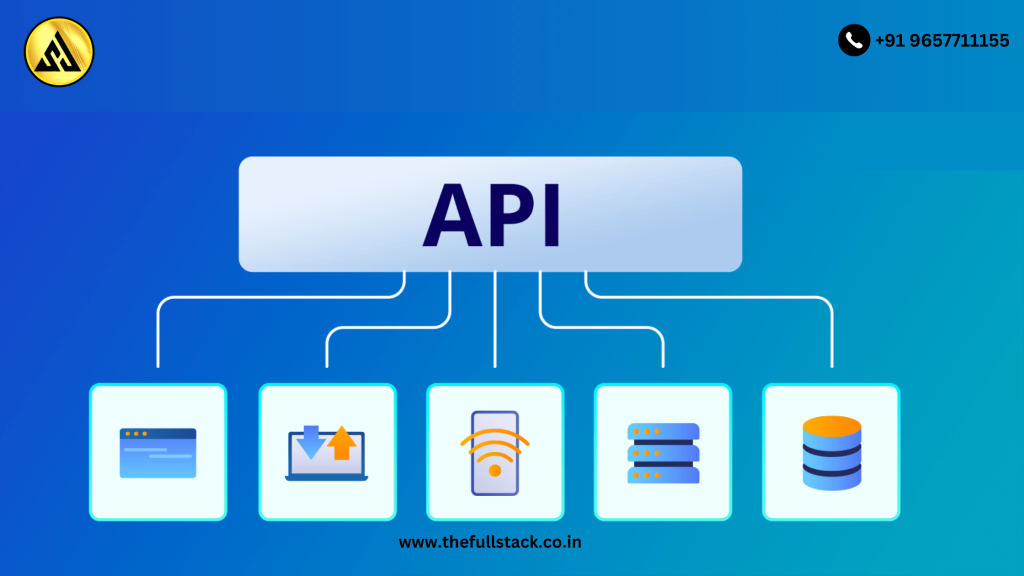Users expect smart features and real-time data in every application in the digital age. Application Programming Interfaces, or APIs, are useful in this situation. APIs power a plethora of functions in contemporary online programs, ranging from payment gateways to weather updates.
This blog post will teach you how to include an API into a full stack application using a straightforward, useful example that uses Node.js with Express for the backend and React for the frontend.
🚀 What is API Integration?
Connecting your application to external services in order to send or retrieve data is known as API integration. It enables developers to increase an application’s capability without having to start from scratch when constructing additions.
🧱 Tech Stack Overview
- Frontend: React.js
- Backend: Node.js + Express.js
- External API Example: Weather data
- Other Tools: Axios, CORS
💡 Why Use APIs in Web Apps?
- ✅ Fetch live data like news, weather, or currency rates
- ✅ Automate services like email or SMS
- ✅ Connect with external platforms
- ✅ Speed up development with ready-made solutions
📘 Real-World Example: Weather App with API Integration
Let’s create a basic weather app. When a user inputs the name of a city, the app uses a full stack technique to retrieve real-time meteorological data from an API.
🔧 Step 1: Backend Setup (Node.js + Express)
🔹 Initialize the Project
npm init -y
npm install express axios cors
🔹 Create server.js
tconst express = require(“express”);
const axios = require(“axios”);
const cors = require(“cors”);
const app = express();
app.use(cors());
const API_KEY = “your_api_key_here”;
app.get(“/api/weather/:city”, async (req, res) => {
const city = req.params.city;
try {
const response = await axios.get(
`https://api.example.com/weather?q=${city}&appid=${API_KEY}&units=metric`
);
res.json(response.data);
} catch (err) {
res.status(500).json({ error: “Failed to fetch data.” });
}
});
app.listen(5000, () => {
console.log(“Backend is running on port 5000”);
});
🖥️ Step 2: Frontend Setup (React)
🔹 Create React App and Install Axios
npx create-react-app weather-client
cd weather-client
npm install axios
🔹 Modify App.js
import React, { useState } from “react”;
import axios from “axios”;
function App() {
const [city, setCity] = useState(“”);
const [weather, setWeather] = useState(null);
const fetchWeather = async () => {
try {
const res = await axios.get(`http://localhost:5000/api/weather/${city}`);
setWeather(res.data);
} catch (err) {
alert(“Could not fetch weather data.”);
}
};
return (
<div style={{ padding: “2rem”, textAlign: “center” }}>
<h2>Simple Weather App</h2>
<input
type=”text”
placeholder=”Enter city name”
onChange={(e) => setCity(e.target.value)}
/>
<button onClick={fetchWeather}>Get Weather</button>
{weather && (
<div style={{ marginTop: “1rem” }}>
<h3>{weather.name}</h3>
<p>{weather.weather[0].description}</p>
<p>{weather.main.temp}°C</p>
</div>
)}
</div>
);
}
export default App;
▶️ Step 3: Run Your Application
- Start backend server:
node server.js
- Start React frontend:
bash
CopyEdit
npm start
Now open your browser, enter a city name, and get live weather updates!
🧠 Best Practices for API Integration
- 🔐 Store API keys in .env files
- ⚙️ Use try-catch for error handling
- 🌐 Enable CORS properly for frontend-backend communication
- 🔄 Cache data if the API has rate limits
📌 More Real-World Use Cases
- Get live stock prices
- Implement payment systems
- Add maps or location services
- Enable social login (Google, Facebook)
✅ Conclusion
A key competency in full stack development is API integration. It enables your app to integrate with strong third-party services, improving functionality and user experience.
Your web apps can reach their maximum potential with just a few lines of code.
You might be like this:-
Top 10 JavaScript Frameworks to Learn in 2025

